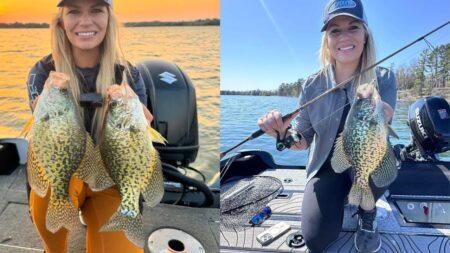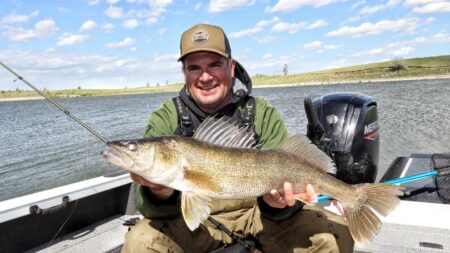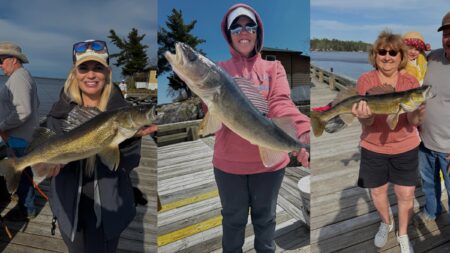Anglers simply love crappie, and big crappie (fish over fourteen inches) are simply a special fish. In all our travels, we encounter a lot of different fish and truthfully… we love them all. Every fish has a fan and we never met a fish we didn’t like but if there is one fish that just seems to create an infatuated obsession across the Midwest, that fish might be a big spring crappie.
Crappie seem to cover all the bases. Crappie can of course be very abundant and easy to find and catch. Crappie are great table fare and provide a lot of action. Big crappie can also devour a topwater or spinner bait while you are bass fishing or break off four-pound mono on a panfish setup. Crappie seem to transcend across and check off every box. Big crappies are rare enough to make them coveted. Big crappies can be ferocious predators. Big crappie spots are often much more guarded by anglers. While you might be able to find crappie on many different rivers, lakes and reservoirs… the big crappie can be much harder to find as not every fishery produces big crappie.

Spring crappie fishing is one of the best combinations of circumstances to find really big fish because the fish are often concentrated in particular locations each spring. Take really big systems that grow gigantic crappie, places like Leech Lake, Winnebago, Lake Oahe, these fisheries are big enough where fish can simply survive for ten or more years. Not to say that small lakes can’t produce big crappie because they do but small lakes are much more susceptible to the effects of harvest. For a crappie to get big… they need to live long enough in an ecosystem that can produce a big fish. River systems can also produce some beautiful crappie as well, especially fisheries with hard-to-reach backwater areas and oxbows.
Crappie can also have population cycles that boom and bust and some fisheries simply have high densities of fish that never get past twelve inches. Regardless of fishery, however, springtime is one of the best times of the year to target some of the largest crappie in a system.
My favorite locations to find spring crappie are protected bays or bogs that warm up much quicker than the main basin of a natural lake or main channel on a river or reservoir. The best locations are often protected enough where wind can’t blow in colder water from the nearby basin. Crappie will often bed in pencil reeds or cattails on natural lakes and we often find crappie using chunk rock on reservoirs. Anglers often look for a peak water temperature in the high fifty to low sixty-degree range. The best indicator I have found, however, is lilac bushes. When the lilacs bloom, the crappie move in shallow.
Cold fronts or cooling water temps can push fish back out deeper and back out of the shallow, protected bays but rising water temps and sunshine bring fish up shallow.

Across the board, doesn’t matter if you are fishing a Missouri Reservoir or a natural lake in northern Wisconsin, most of the spring crappie fishing is a relatively shallow affair. Most fish are less than ten feet and typically during stable, warming weather… most fish are usually less than five feet of water.
Many anglers cut their teeth fishing for crappie with bobbers and minnows and this simple program catches a lot of crappie, especially when the fish are just off from cold fronts. Hair jigs and soft plastics below bobbers, however, are beginning to dominate the spring crappie scene. Both hair and plastic are exceptionally durable and effective. You can simply catch more fish without the hassle of live bait. Because fish are shallow, we are typically casting to fish and casting with a hair jig or jig and soft plastic is simply more efficient.
A simple clip-on pencil bobber is used for bite detection and for controlling the depth. In many shallow areas, there will be weed growth coming off the bottom. Set your bobber so that the jig rides above the weeds. A good starting point is halfway between the surface and the tops of the weed growth.
Because we often are casting to reach fish, longer rods can be an advantage for reaching fish with light tackle. The Scheels seven-foot Guide Series spinning rod in the light/ fast action is a great rod action. Pair the rod up with a Scheels Pro Angler 1000 size spinning reel for a great feeling spinning rod and reel combo with good balance.
For casting light jigs and small bobbers, I love the Berkley Nanofil in six-pound test. Because this braided line is so thin, you will have to wrap the line around the bobber spring a few times to keep the bobber from slipping. In deeper water past about five feet, where slip bobbers are necessary, switch over to four-pound Berkley XL so that the bobber stop can grip the line. Note that in heavier pencil reeds and wood cover, don’t be afraid to get heavier with an eight-pound test to keep fish from wrapping up and breaking off. When searching through open water, you can use lighter line and the Nanofil is excellent for making long casts in shallow water. For heavier cover, use heavier line. When using Nanofil or any kind of braid, I usually use a four-pound mono or fluorocarbon leader that is about two to three feet long.
For sifting through water faster, don’t be afraid to use a heavier 1/8th ounce jig so that you can reel and work the bobber back to the boat slightly faster. Once you eliminate water and find fish, you can drop down to a 1/16th or 1/32nd ounce jig to slow down. The Strike King Mr. Crappie Slab Slasher jig heads are perfect but make sure the jig rides perfectly horizontal on the jig knot. I have found that a loop knot works well for keeping crappie jigs riding horizontal and swimming below the bobber properly.
Durable soft plastic options include the Scheels Outfitters Crappie Minnow and Crappie Swimbait along with the Strike King Mr. Crappie Lightning Shad. Both plastics are close to two inches long and are not only durable but have the gliding action and profile that crappie seem to love. Besides soft plastics, hair jigs are also incredibly deadly for spring crappie and are often even more durable than soft plastics. Popular hair jigs include the classic Northland Fishing Tackle Fire-Fly Jig.

You can find crappie with a temperature gauge and you can also use your intuition. Traditionally, we found crappie simply covering water by casting the bobber and jig set up described above. If there are a couple of tools available today however that didn’t exist a decade ago, those tools would be the Lowrance side imaging and the Active Target transducer. The side imaging can work extremely well to simply find fish in shallow water, especially fish that are in four to ten feet of water, halfway down in the water column or over a clean, smooth bottom. The Active Target enables you to see how the fish are moving and allows you to follow the fish. Both transducers complement each other and offer an effective one-two punch that we couldn’t have fathomed a decade ago.
In many regions across the Midwest, spring crappie fishing is one of the hottest tickets. Many states also have closed game fish seasons where crappie fishing opportunities are one of the few open fishing seasons. Anglers can get their boats wet and target a fish that is in season. Don’t know of many anglers that don’t enjoy targeting crappie. A great fishing opportunity that is a right of passage each spring.
Gear:
Thill America’s Favorite Float
Berkley Nano Fil
Berkley Trilene
Scheels Outfitters Crappie Minnow
Strike King Mr. Crappie Slab Slasher Jig Head
Scheels Outfitters Crappie Swimbait
Strike King Mr. Crappie Lightning Shad
Northland Fire-Fly Jig
Lowrance 12″ HDS
Lowrance Active Imaging 3-in-1 Transducer




